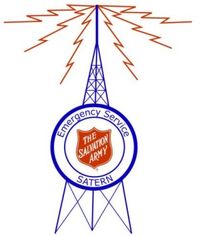
Salvation Army Team Emergency Radio Network
Salvation Army Team Emergency Radio Network (SATERN) volunteers are ham radio operators communicating worldwide to assist in times of disaster...
NH2Z. That's his radio call sign, but he's also known as Al Shaver, a retired United Airlines senior captain who flew 747s on weekly international routes. In his days off, he attended the University of Chicago where he met his wife Ann (WH2E) and where each earned doctoral degrees in social sciences. Now living in Hawaii, they learned of SATERN through a notice about a Salvation Army disaster services seminar. SATERN so intrigued them that they flew to the mainland to attend. Today they are SATERN volunteers and edit its newsletter, The SATERN Ring.
W9IB, Harry Gilling, was driving in the Chicago area when a car pulled alongside him. The driver was WW9E, Major Patrick McPherson, Central Territorial disaster services director and international coordinator of SATERN. McPherson had noticed the radio antenna on Gilling's car and signaled to him to tune in on the mobile radio frequency. Always eager to recruit volunteers, McPherson told him via radio about SATERN and the growing network helping with Salvation Army disaster services. A retired communications manager for United Airlines, today Gilling coordinates the world-wide continental SATERN 20-meter net from the metropolitan Chicago area.
W8WZ (Carl Davis) and N8VTF (Don Evans) are two amateur radio operators from Mt. Clemens, whose lives took a new direction because of SATERN. Davis is now a cadet in The Salvation Army College for Officers, and Evans became a local corps officer, and head of SATERN in Mt. Clemens, which serves the Detroit area.
In June 1988, McPherson with the help of Art Evans organized SATERN with three ham operators. Today, besides operating in the U.S., SATERN has links to the United Nations and Western Europe and operates in Australia, Canada, Mexico, Great Britain, Russia, the former Czechoslovakia and other countries.
"As important as communications are, that isn't the whole story," says McPherson. "Every SATERN volunteer has other tremendous skills to offer in an emergency. For example, one man, an expert in engine maintenance, is our motor vehicle officer. SATERN volunteers are part of our team not only because they want to help us communicate, but because they want to help others."
Now celebrating a decade of service in emergency disaster response, SATERN is committed to communicating and caring.
NH2Z, WH2E, W9IB and WW9E are among more than a thousand amateur radio operators who comprise SATERN. They are men and women of all ages and from all walks of life, including the disabled, who share a love for short-wave broadcasting and a heart for serving others. About 200 SATERN volunteers server the Greater Chicago area alone, backing up another 200 disaster volunteers who assist on canteens and in other capacities.
SATERN volunteers meet regularly on city, state, regional, national and international radio networks. The meetings have two purposes: one to provide disaster training and keep volunteers informed about new emergency procedures; and two, to be available at a moments notice to relay messages during local, national and international disasters. When an emergency strikes, SATERN volunteers are at their radios within minutes, helping coordinate disaster services. Often in widespread devastation, such as in Hurricane Andrew, SATERN is the public's only link to friends and loved ones.
"Usually a disaster wipes out communication lines, or those that exist are being used by authorities and the media," say McPherson. "People can't get through to find out about their loved ones. Our network often can help locate them and relay messages. Just knowing someone is doing something to help eases people's minds."
With no shortage of disasters, SATERN volunteers have served during tornadoes, floods, hurricanes, fires, aircraft accidents, bombings and earthquakes. They've assisted at the Oklahoma bombing site, the North Dakota floods and the New England ice storms.